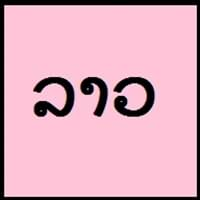Filipino vs Lao
Countries
Philippines
Laos
National Language
Philippines
Laos, Northeastern Thailand
Second Language
Philippines
Not spoken in any of the countries
Speaking Continents
Asia
Asia
Minority Language
Not spoken in any of the countries
Not spoken in any of the countries
Regulated By
Komisyon sa Wikang Filipino
Not Available
Interesting Facts
- "Filipino" was officially declared as national language by the constitution in 1987.
- "Filipino" is the official name of Tagalog, or synonym of it.
- There is no space left between words, only between phrases or sentences in Lao language.
- The Lao alphabets has been reformed many times over the past 50 years.
Similar To
Tagalog Language
Thai Language
Derived From
Spanish Language
Pali, Sanskrit and Old Khmer Languages
Alphabets in
Filipino-Alphabets.jpg#200
Lao-Alphabets.jpg#200
Scripts
Latin
Thai and Lao Braille
Writing Direction
Not Available
Left-To-Right, Horizontal
Hello
Kumusta
ສະບາຍດີ (sába̖ai-di̖i)
Thank You
Salamat
ຂອບໃຈ (khàwp ja̖i)
How Are You?
Kumusta
ສະບາຍດີບ (sába̖ai-di̖i baw?)
Good Night
magandang gabi
ໃນຕອນກາງຄືນ ທີ່ດີ (naitonkangkhun thidi)
Good Evening
Magandang gabi
ສະບາຍດີຕອນແລງ (sa bai di ton aelng)
Good Afternoon
Magandang hapon
ສະບາຍດີຕອນສວາຍ (sa bai di ton suaai)
Good Morning
Magandang umaga
ສະບາຍດີຕອນເຊົ້າ (sa bai di ton sao)
Please
Mangyaring
ກະລຸນາ (kaluna)
Sorry
pinagsisisihan
ຂໍອະໄພ (khooaphai)
I Love You
Mahal kita
ຂ້ອຍຮັກເຈົ້າ (khony hak chao)
Excuse Me
patawarin ninyo ako
ຂໍໂທດ (kho othd)
Dialect 1
Bikol
Vientiane Lao
Where They Speak
Philippines
Laos
Dialect 2
Hiligaynon
Northern Lao
Where They Speak
Philippines
Laos
How Many People Speak
Not Available
Dialect 3
Waray
Central Lao
Where They Speak
Philippines
Laos
How Many People Speak
Not Available
Speaking Population
Not Available
Not Available
Second Language Speakers
Not Available
Native Name
filipino
ພາສາລາວ (pháasaa láo)
Alternative Names
Pilipino
Eastern Thai, Lào, Lao Kao, Lao Wiang, Lao-Lum, Lao-Noi, Lao-Tai, Laotian, Laotian Tai, Lum Lao, Phou Lao, Rong Kong, Tai Lao
French Name
filipino; pilipino
lao
German Name
Pilipino
Laotisch
Pronunciation
[ˌfɪl.ɪˈpiː.no]
pʰáːsǎː láːw
Ethnicity
Not Available
Not Available
Origin
16th Century
1283 CE
Language Family
Austronesian Family
Tai-Kadai Family
Subgroup
Not Available
Tai
Branch
Not Available
Not Available
Early Forms
No early forms
No Early forms
Standard Forms
Filipino
Lao
Signed Forms
Not Available
Not Available
Scope
Individual
Individual
ISO 639 1
No Data Available
lo
ISO 639 6
Not Available
Not Available
Glottocode
fili1244
laoo1244
Linguasphere
No Data Available
No data available
Language Type
Living
Living
Language Linguistic Typology
Not Available
Subject-Verb-Object
Language Morphological Typology
Not Available
Isolating
Filipino and Lao Language History
Comparison of Filipino vs Lao language history gives us differences between origin of Filipino and Lao language. History of Filipino language states that this language originated in 16th Century whereas history of Lao language states that this language originated in 1283 CE. Family of the language also forms a part of history of that language. More on language families of these languages can be found out on Filipino and Lao Language History.
Filipino and Lao Greetings
People around the world use different languages to interact with each other. Even if we cannot communicate fluently in any language, it will always be beneficial to know about some of the common greetings or phrases from that language. This is where Filipino and Lao greetings helps you to understand basic phrases in Filipino and Lao language. Filipino word for "Hello" is Kumusta or Lao word for "Thank You" is ຂອບໃຈ (khàwp ja̖i). Find more of such common Filipino Greetings and Lao Greetings. These greetings will help you to be more confident when conversing with natives that speak these languages.
Filipino vs Lao Difficulty
The Filipino vs Lao difficulty level basically depends on the number of Filipino Alphabets and Lao Alphabets. Also the number of vowels and consonants in the language plays an important role in deciding the difficulty level of that language. The important points to be considered when we compare Filipino and Lao are the origin, speaking countries, language family, different greetings, speaking population of these languages. Want to know in Filipino and Lao, which language is harder to learn? Time required to learn Filipino is 44 weeks while to learn Lao time required is 44 weeks.





